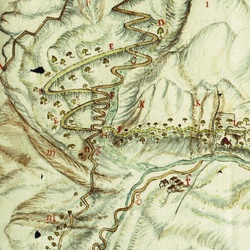Via Vandelli
Valle del Serchio. Più vicino a te

The idea to build this formidable public work arose from the marriage of Duke Ercole Rinaldo d’Este to Maria Teresa Cybo-Malaspina, heir of the Duke of Massa and Carrara. A marriage firmly sought by Ercole's father, Francesco III d’Este, who was thereby guaranteed to increase the size of his state and an outlet to the Tyrrhenian Sea.
To enable the easy movement of goods, men and soldiers from Modena to Massa, the two ends of the Estense domain, it was deemed necessary to build a road that, by overcoming the mountains of the Apennines, would enable the distance between the two cities to be covered in the shortest time possible and the minimum of effort.
The commission to design and carry out the works was assigned to the Abbot Domenico Vandelli, a profoundly cultured man. The commission proposed was not simple to complete, since the Duke demanded that the arterial road had features that were a real challenge for the designer. The road had to allow the passage of heavy carriages, so that it could be used to transport the heavy Carrara marble to Modena, a decision that required a minimum gradient to be respected. Moreover, for the purpose of avoiding disputes with neighbouring states, Francesco III obliged Vandelli to design a stretch that passed only through Estense lands without being connected to the routes of the state of Lucca and the Grand Duchy of Tuscany. Another request was to carry out the operation following criteria of extreme parsimony, including the costs for future maintenance.
The many constraints obliged Vandelli to rack his brain to come up with new methods for making topographic maps, indispensable tools to understand the real contours of the terrain. To this end, Vandelli devised the so-called “system of contour lines”, named in his honour isoipsae Vandellis, lines that join points of the same height, enabling altimetry to be represented on a flat surface.
Vandelli devised large rest areas for travellers, such as those on Mount Tambira, called the Vandelli Window, where bulky goods could be stored, loaded and unloaded.
Thereafter, services were added that were indispensable for the road to be used effectively: refreshment stations to rest and water animals, taverns, places for loading and unloading goods in transit, devotional carvings and look-outs, both to avoid bandits and to ensure the road was not used by smugglers.
In any event, in spite of the innovative techniques used, the Via Vandelli remained difficult to use yet nevertheless continued to be travelled for a long time, useful more for short journeys that long trips.



